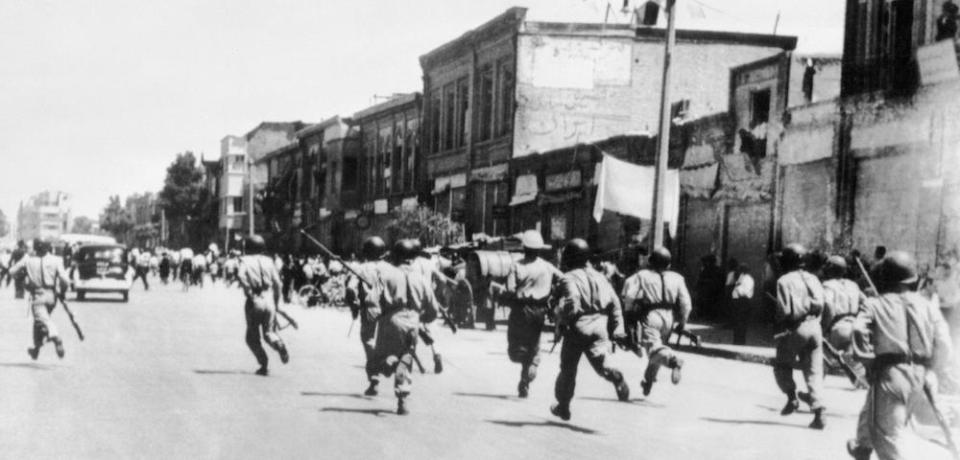64 Years Later, CIA Finally Releases Details of Iranian Coup
IN FOCUS, 26 Jun 2017
Bethany Allen-Ebrahimian | Foreign Policy – TRANSCEND Media Service
New documents reveal how the CIA attempted to call off the failing coup — only to be salvaged at the last minute by an insubordinate spy.

Persian soldiers chase rioters during civil unrest in Tehran, August 1953. On August 19, 1953, democratically-elected Iranian Prime Minister Mohammad Mossadegh was overthrown in a coup orchestrated by the CIA and British intelligence, after having nationalized the oil industry. The Shah Mohammad Reza Pahlavi was re-installed in the primary position of power. Massive protests broke out across the nation, leaving almost 300 dead in firefights in the streets of Tehran. (AFP/Getty Images)
20 Jun 2017 – Declassified documents released last week shed light on the Central Intelligence Agency’s central role in the 1953 coup that brought down Iranian Prime Minister Muhammad Mossadegh, fueling a surge of nationalism which culminated in the 1979 Iranian Revolution and poisoning U.S.-Iran relations into the 21st century.
The approximately 1,000 pages of documents also reveal for the first time the details of how the CIA attempted to call off the failing coup — only to be salvaged at the last minute by an insubordinate spy on the ground.
Known as Operation Ajax, the CIA plot was ultimately about oil. Western firms had for decades controlled the region’s oil wealth, whether Arabian-American Oil Company in Saudi Arabia, or the Anglo-Iranian Oil Company in Iran. When the U.S. firm in Saudi Arabia bowed to pressure in late 1950 and agreed to share oil revenues evenly with Riyadh, the British concession in Iran came under intense pressure to follow suit. But London adamantly refused.
So in early 1951, amid great popular acclaim, Mossadegh nationalized Iran’s oil industry. A fuming United Kingdom began conspiring with U.S. intelligence services to overthrow Mossadegh and restore the monarchy under the shah. (Though some in the U.S. State Department, the newly released cables show, blamed British intransigence for the tensions and sought to work with Mossadegh.)
The coup attempt began on August 15 but was swiftly thwarted. Mossadegh made dozens of arrests. Gen. Fazlollah Zahedi, a top conspirator, went into hiding, and the shah fled the country.
The CIA, believing the coup to have failed, called it off.
“Operation has been tried and failed and we should not participate in any operation against Mossadegh which could be traced back to US,” CIA headquarters wrote to its station chief in Iran in a newly declassified cable sent on Aug. 18, 1953.
“Operations against Mossadegh should be discontinued.”
“Operations against Mossadegh should be discontinued.”
That is the cable which Kermit Roosevelt, top CIA officer in Iran, purportedly and famously ignored, according to Malcolm Byrne, who directs the U.S.-Iran Relations Project at the National Security Archive at George Washington University.
At least “one guy was in the room with Kermit Roosevelt when he got this cable,” Byrne told Foreign Policy. “[Roosevelt] said no — we’re not done here.” It was already known that Roosevelt had not carried out an order from Langley to cease and desist. But the cable itself and its contents were not previously published.
The consequences of his decision were momentous. The next day, on August 19, 1953, with the aid of “rented” crowds widely believed to have been arranged with CIA assistance, the coup succeeded. Iran’s nationalist hero was jailed, the monarchy restored under the Western-friendly shah, and Anglo-Iranian oil — renamed British Petroleum — tried to get its fields back. (But didn’t really: Despite the coup, nationalist pushback against a return to foreign control of oil was too much, leaving BP and other majors to share Iran’s oil wealth with Tehran.)
Operation Ajax has long been a bogeyman for conservatives in Iran — but also for liberals. The coup fanned the flames of anti-Western sentiment, which reached a crescendo in 1979 with the U.S. hostage crisis, the final overthrow of the shah, and the creation of the Islamic Republic to counter the “Great Satan.”
The coup alienated liberals in Iran as well. Mossadegh is widely considered to be the closest thing Iran has ever had to a democratic leader. He openly championed democratic values and hoped to establish a democracy in Iran. The elected parliament selected him as prime minister, a position he used to reduce the power of the shah, thus bringing Iran closer in line with the political traditions that had developed in Europe. But any further democratic development was stymied on Aug. 19.
The U.S government long denied involvement in the coup.
The U.S government long denied involvement in the coup. The State Department first released coup-related documents in 1989, but edited out any reference to CIA involvement. Public outrage coaxed a government promise to release a more complete edition, and some material came out in 2013. Two years later, the full installment of declassified material was scheduled — but might have interfered with Iran nuclear talks and were delayed again, Byrne said. They were finally released last week, though numerous original CIA telegrams from that period are known to have disappeared or been destroyed long ago.
Byrne said that the long delay is due to several factors. Intelligence services are always concerned about protecting “sources and methods,” said Byrne, meaning the secret spycraft that enables them to operate on the ground. The CIA also needed to protect its relationship with British intelligence, which may have wished some of the material remain safeguarded.
Beyond final proof of CIA involvement, there’s another very interesting takeaway in the documents, said Abbas Milani, a professor of Iranian studies at Stanford University: New details on the true political leanings of Ayatollah Abol-Ghasem Kashani, a cleric and leading political figure in the 1950s.
In the Islamic Republic, clerics are always the good guys. Kashani has long been seen as one of the heroes of nationalism during that period. As recently as January of this year, Iran’s supreme leader praised Kashani’s role in the nationalization of oil.
Kashani’s eventual split from Mossadegh is widely known. Religious leaders in the country feared the growing power of the communist Tudeh Party, and believed that Mossadegh was too weak to save the country from the socialist threat.
But the newly released documents show that Kashani wasn’t just opposed to Mossadegh — he was also in close communication with the Americans throughout the period leading up to the coup, and he actually appears to have requested financial assistance from the United States, though there is no record of him receiving any money. His request was not previously known.
On the make-or-break day of Aug. 19, “Kashani was critical,” said Milani. “On that day Kashani’s forces were out in full force to defeat Mossadegh.”
Clarification, June 21, 2017: This piece has been clarified to state that at least one person was in the room when Roosevelt received the August 18 cable, and that the cable was unpublished until now.
___________________________________________
 Bethany Allen-Ebrahimian is an assistant editor at Foreign Policy. Before joining Foreign Policy, she lived and worked in China for more than four years. Bethany is a Jefferson Fellow with the East-West Center in Honolulu, Hawaii. She holds an M.A. in East Asian studies from Yale University and a graduate certificate from the Hopkins-Nanjing Center for Chinese and American Studies.
Bethany Allen-Ebrahimian is an assistant editor at Foreign Policy. Before joining Foreign Policy, she lived and worked in China for more than four years. Bethany is a Jefferson Fellow with the East-West Center in Honolulu, Hawaii. She holds an M.A. in East Asian studies from Yale University and a graduate certificate from the Hopkins-Nanjing Center for Chinese and American Studies.
Go to Original – foreignpolicy.com
DISCLAIMER: The statements, views and opinions expressed in pieces republished here are solely those of the authors and do not necessarily represent those of TMS. In accordance with title 17 U.S.C. section 107, this material is distributed without profit to those who have expressed a prior interest in receiving the included information for research and educational purposes. TMS has no affiliation whatsoever with the originator of this article nor is TMS endorsed or sponsored by the originator. “GO TO ORIGINAL” links are provided as a convenience to our readers and allow for verification of authenticity. However, as originating pages are often updated by their originating host sites, the versions posted may not match the versions our readers view when clicking the “GO TO ORIGINAL” links. This site contains copyrighted material the use of which has not always been specifically authorized by the copyright owner. We are making such material available in our efforts to advance understanding of environmental, political, human rights, economic, democracy, scientific, and social justice issues, etc. We believe this constitutes a ‘fair use’ of any such copyrighted material as provided for in section 107 of the US Copyright Law. In accordance with Title 17 U.S.C. Section 107, the material on this site is distributed without profit to those who have expressed a prior interest in receiving the included information for research and educational purposes. For more information go to: http://www.law.cornell.edu/uscode/17/107.shtml. If you wish to use copyrighted material from this site for purposes of your own that go beyond ‘fair use’, you must obtain permission from the copyright owner.